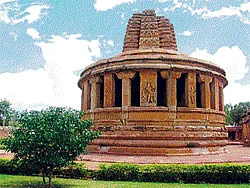

The magnificent monuments of ancient and medieval India and the country’s richly varied folk arts have inspired many a modern structure. Even Indian luxury trains have been inspired. Take the Rajasthan art-and-architecture-inspired Palace on Wheels and Maharashtra’s Deccan Odyssey which reflect local heritage to namma Karnataka’s Golden Chariot.
Hampi style pillars, Yakshagana masks, brass artifacts, Mysore-silk furnishings, and framed pictures of the State’s monuments with names and brief histories of different dynasties––a walk through the Golden Chariot is like a crash course in Karnataka’s history and culture.
Mumbai-based Pramod and Kusum Pendse of Pendse and Associates won the project. The whole process of designing and conceptualisation took nearly two years. It began with a brief given by Karnataka State Tourism Development Corporation (KSTDC) that the train should reflect the State’s heritage in art and architecture as fully and aesthetically as possible. All this while maintaining “five-star standards” i.e a train which catered to the high-end national and international tourist looking for a luxurious voyage to the State’s nationally and internationally famed destinations.
For Pendse and Associates––architectural and interior-design consultants handling multidisciplinary projects including hospitality, corporate, and special segments like luxury trains––this was a big challenge. Of course, they had already successfully created and implemented the Deccan Odyssey project.
But Karnataka and its unique heritage was a different territory. “However, it was not unknown territory. We were familiar with south Indian architecture thanks to Pramod having studied the history of Indian architecture in college and also a few previous projects we had worked on which involved research into this area. Moreover, Pramod had created a Belur-inspired Ganapati decades ago. So, we welcomed this challenge,” says Kusum Pendse.
The first step was, on KSTDC’s advice, touring the State and its famed tourist attractions, most of which were on the luxury train’s itinerary. So, the couple visited Mysore, Aihole, Halebid, Belur, Pattadakal, Hampi and Badami. “We absorbed as much as we could both about the overall structures as well as fine details,” they reveal.
The influences of all these places had to be reflected in the layout of the Chariot with its 18 coaches, 11 cabin coaches, two restaurant coaches, one bar coach, one gym-and-rejuvenation centre coach, one staff coach, and two power coaches. Space constraints were another challenge, after all, these were rooms onboard a train and not sprawling resort suites or villas.
Three styles for the coaches
Three major styles of Karnataka were identified and used for these coaches––Mysore, Halebid and Belur. So, there are four coaches in Halebid Style and three in Belur style.
“While developing designs of interiors of Halebid and Belur style coaches, various elements of stone carving have been carefully combined in the simple design frame of the interior features of bed, headboards, doors, ceiling, etc., reveal the Pendses. These were teamed with the famed silk of Karnataka as also its cotton fabric in elegant designs. And Kasuti-type embroidery work was used on thick tussar silk for bedspreads in Belur coaches.
The Mysore style was employed in four coaches. So there was a typical Mysore Palace style arch pattern for headboard and vault ceiling with carved bands for the ceiling. The entrance door was also styled on Mysore Palace design. The bedspread fabric has typical paisley design which many Indian maharajas were fond of.
Nalapaka or the restaurant coach is styled after the Vittala temple in Hampi. It reveals typical columns of its famed chariot with decorative brackets.
The ceiling, the pelmet above the window and banquette sofas are inspired by the temple roof though the upholstery is contemporary. Ruchi, the restaurant coach, reflects Halebid temple inspiration. It has intricate lace-type carving on the ceiling and typical Deccan-style columns and carvings on the banquette sofa. The scallop on windows has appliqué work done on silk, to match the Halebid-style carving.
A luxury train is incomplete without a bar. The Golden Chariot’s watering hole is the Madira. This bar is inspired by the Mysore Palace with its beautiful colonnade, combined with backlit floral-design grills.
“We made a mirrored false ceiling to reflect the grandeur of a palace-inspired interior,” explain the Pendses. The sofa and sofa chairs are colonial style.
The health club Arogya is more contemporary though the massage rooms have Yakshagana masks to accessorise the walls. The rooms and coaches are named after the different dynasties which ruled Karnataka so a guest will find himself assigned to one of these dynasties, Chalukya, Bahamani, Adilshahi, Rashtrakuta, Shathvahana, Kadamba, Vijayanagara, Yadukula, Sangama, Ganga or Hoysala. And each coach has one prominently placed frame containing a summary of the history of the dynasty after which it is named.
The art work for the train was preceded by a brief survey of the arts and crafts available in museums including rural-craft museums.
Finally, the best of these traditions were made use of. So the train’s interiors showcase leather puppets, hand-painted wooden dices, Dashavatara or Ganjifa-playing cards, Yakshagana masks, mina-work, sandalwood craft, wooden-painted toys, etc. These are in addition to the several photographs of the State’s most popular monuments.
Besides, there was the more demanding task of making of the train itself. Chennai was close to Bangalore, so the Integral Coach Factory here was chosen to make the Golden Chariot. As design consultants, the Pendses had to co-ordinate the total development of the train including its M S framework, metalwork, plumbing work, air-conditioning work, electrical work, painting, etc.
This was the toughest part given the weather conditions at Chennai explain the Pendses. However, after nearly two years of hard work, beginning from July 2006 to March 2008, the Golden Chariot was made ready for KSTDC. “It was a tough and demanding project but we enjoyed exploring and projecting the great Karnataka heritage in art, architecture and culture,” they conclude.
